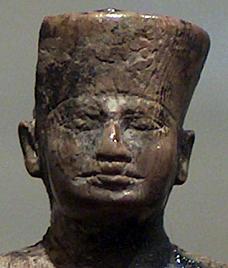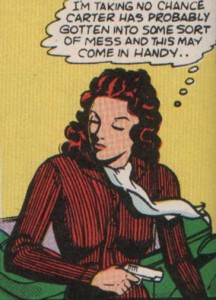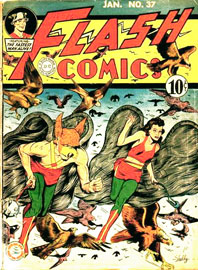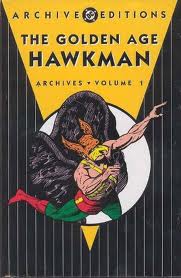 Hawkman has been one of my favorite comic characters since I first heard of him back in the early 1970s. You might rightly ask if there’s a comic book character I’ve heard of who is not one of my favorites. A fair question. I don’t like Lobo or the Punisher. Wolverine wears on me after a while. He’s a great supporting character on a team, but I have little desire to read a whole book (or see a whole movie, even starring Hugh Jackman) about him. But if you were to ask me if there was a character created before 1975 who isn’t a favorite, well, probably no. I love them all. Each for different reasons.
Hawkman has been one of my favorite comic characters since I first heard of him back in the early 1970s. You might rightly ask if there’s a comic book character I’ve heard of who is not one of my favorites. A fair question. I don’t like Lobo or the Punisher. Wolverine wears on me after a while. He’s a great supporting character on a team, but I have little desire to read a whole book (or see a whole movie, even starring Hugh Jackman) about him. But if you were to ask me if there was a character created before 1975 who isn’t a favorite, well, probably no. I love them all. Each for different reasons.
In Hawkman’s case, I loved the fact that he came from another planet. I loved that his wife Hawkgirl was his equal partner in adventure. (She was later Hawkwoman, when we became socially aware, and then Hawkgirl again, when social awareness, um… took a cruise? I’m not sure.) I loved that he dressed in red, yellow and green. Not everyone can pull that off. There’s definitely not enough green in the superhero spectrum. If recent films are to be believed, there’s little color at all. Isn’t it sad that, after they went to all the trouble to invent Technicolor, that our films (superhero and otherwise) are now effectively in black and white again, they’re so drab? No, that’s not fair. Black and white films of yesteryear had far more color than many of our films do today.
Now the Golden Age Hawkman is not from another planet. He’s a scientist and scholar who happens to be a millionaire (don’t judge) and rocks a top hat. I first discovered him when DC Comics published their tabloid-sized Famous First Editions, around the same time I started reading comics. I ordered every one I could scrap up the money for. Still have them. These things were great. I could talk about them all day. Fortunately, I don’t have to. There’s a wonderful tribute site for them here.
 Flash Comics #1 contained a double (triple, really) play. It introduced the original Flash, Johnny Thunder, a lesser-known but historically important comedic hero, and the original Hawkman. In this story I learned that, before Katar Hol and Shayera Thal, police officers from the planet Thanagar in the Polaris system, came to Earth and took the names Carter and Shiera Hall (as well as Hawkman and Hawkgirl), socialite scientist Carter Hall met a girl named Shiera Sanders, and they became Hawkman and Hawkgirl as well. Okay, she didn’t become Hawkgirl in that first issue. In fact, she doesn’t become Hawkgirl in the course of the 21 issues covered in The Golden Age Hawkman Archives. But the black-tressed (later just brunette) Shiera did become a costumed super-heroine before Wonder Woman first appeared.
Flash Comics #1 contained a double (triple, really) play. It introduced the original Flash, Johnny Thunder, a lesser-known but historically important comedic hero, and the original Hawkman. In this story I learned that, before Katar Hol and Shayera Thal, police officers from the planet Thanagar in the Polaris system, came to Earth and took the names Carter and Shiera Hall (as well as Hawkman and Hawkgirl), socialite scientist Carter Hall met a girl named Shiera Sanders, and they became Hawkman and Hawkgirl as well. Okay, she didn’t become Hawkgirl in that first issue. In fact, she doesn’t become Hawkgirl in the course of the 21 issues covered in The Golden Age Hawkman Archives. But the black-tressed (later just brunette) Shiera did become a costumed super-heroine before Wonder Woman first appeared.
Carter and Shiera (the 1940s versions of them) meet by accident. Actually, it’s fate which brings them together, but they don’t know it yet. It goes like this: Collector Carter Hall receives a package from his friend Jim Rock in Egypt. It contains a glass knife. Seeing it, Carter becomes sleepy. He passes out and dreams that he’s an Egyptian Prince named Khufu. (He’s still blond-haired and blue-eyed, of course. I find it pretty doubtful that the real Khufu, a Pharaoh from around 2580 B.C., was blond.) His enemy, Hath-Set, tracks down and kills both Khufu and his beloved, Shiera. Um… with a glass knife. I don’t want to participate in any tests, but isn’t glass a little bit of a brittle substance to be used for sacrificial knives? I could be wrong…
Shiera is a name that is apparently not listed in the Social Security database, so, even now, no one in America is naming their kid that. The only other reference I can find to the name is in a game of thrones wiki. So, whatever it is, this name is probably not authentic Egyptian. But at least she looks like she could be Egyptian. Well, her hair is black.
As they die, Khufu vows to return for revenge: “I die–but I shall live again–as shall you, Hath-Set, and then I shall be the victor!”
Rattled by this dream, Carter goes for a walk around the block. Passing a subway station, he hears passengers shrieking that the rails are turning blue and the train’s on fire. Running to investigate, he bumps into the girl from his dream. When he calls her by name, she asks how he could know her name. (How could anybody know her name is more to the point. It’s a made-up name!) They discover that Dr. Hastor, the reincarnation of Hath-Set, is responsible for the blazing subway rails. He’s experimenting with electricity. He somehow turns Shiera into a zombie, forcing Carter to go to the rescue. He puts on green tights, a hawk mask, and a pair of wings, as you do in such circumstances. Seems Carter has invented / discovered (both terms are used) a substance called the Ninth Metal. It defies gravity. It also keeps you warm in the winter. (Not kidding!) Either his wings or his belt are made of it. Carter flies off and saves Shiera from being sacrificed to the god Anubis, after which he fires a crossbow at Hastor, killing him. He tells Anubis (that statue of Anubis, anyway) that Hastor is dead, but he doesn’t tell the cops. Hmmmm. Well, fair enough. The guy killed him in a past life, and did just try to kill his girlfriend again. Hardly admissible in court, though. And what the hell did he do with the body?
Just wait. It only gets more violent.
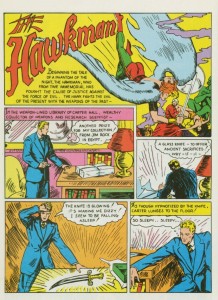 A bit of history first. Gardner Fox and Dennis Neville created Hawkman. I’ve read in interview that Fox shamelessly swiped the idea of a hawk-man from Flash Gordon. Lotsa swiping went on then. No one ever imagined that a comic book would survive a year, much less seventy-three of them. It’s pretty clear that he also read his Edgar Rice Burroughs, as the Ninth Ray is one of the rays of sunlight which keeps Barsoomians alive by powering their air processing plants. The Ninth Ray was blue, and so were Carter’s Ninth-Metal wings for the first four or five issues. I think it’s safe to assume that ERB was the inspiration for the Ninth Metal. Of course, somewhere along the line, the name was changed to “Nth Metal.” I have no idea what powers the New 52 Hawkman’s wings. Sheer gall, most likely. Or perhaps the blood of dead Bronze Age Comics readers.
A bit of history first. Gardner Fox and Dennis Neville created Hawkman. I’ve read in interview that Fox shamelessly swiped the idea of a hawk-man from Flash Gordon. Lotsa swiping went on then. No one ever imagined that a comic book would survive a year, much less seventy-three of them. It’s pretty clear that he also read his Edgar Rice Burroughs, as the Ninth Ray is one of the rays of sunlight which keeps Barsoomians alive by powering their air processing plants. The Ninth Ray was blue, and so were Carter’s Ninth-Metal wings for the first four or five issues. I think it’s safe to assume that ERB was the inspiration for the Ninth Metal. Of course, somewhere along the line, the name was changed to “Nth Metal.” I have no idea what powers the New 52 Hawkman’s wings. Sheer gall, most likely. Or perhaps the blood of dead Bronze Age Comics readers.
In the second adventure, things are a little confusing as a “Modern Alexander the Great,” also one of Carter’s society friends, invites Carter and Shiera to dinner to issue a blatant challenge to the Hawkman. Apparently, his costumed identity is widely known. In later issues it was a secret. New Alexander has a weight gun, and he wants to use it to take over the world. He knows Hawkman can stop him, so he offers Carter a million dollars to look the other way. When Carter declines, he lets him leave in peace, and invites him to come visit any time. It’s all very civilized, dontchaknow… until Hawkman stabs his host in the throat with a trident, leaves the body and takes his weight machine for Carter’s weapons collection. And then Carter and Shiera argue about whether to have breakfast or finish their evening cocktails. Shiera seems to sleep over a lot. Quite risqué for the 1940s, especially in a comic book.
Una Cathay is an evil scientist who keeps dead scientists alive so she can use their brains. Hawkman throws a knife into the tire of her speeding car as she tries to escape him. She breaks her neck in the resulting crash. (So that’s an accident, but, after all, she’s a girl.)
Sheldon Moldoff, one of the Golden Age greats of penciling, took over Hawkman with the fourth issue of Flash Comics. In Shelly’s first adventure, nobody dies, but Hawkman does nearly strangle an evil hypnotist to get him to talk.
The next two adventures feel very James Bond. Carter wings off without even thinking of Shiera and helps G-Man (G-Woman?) Ione Craig prevent the assassinations of world leaders by Muslim terrorists. We get to see blonde Ione in chains showing plenty of thigh, so that’s nice. The Hawk (as he was called for many of his early stories) “fights his way across the room” against a whole mess of terrorists to free Ione from the chains. We don’t see what happens to those who are put to his sword, but we do see him kill Hassan Ibn Sadah, their leader, with a slingshot. So it looks like that no-killing thing was a one-issue fluke. On the way back to the US, Ione is kidnapped and brought before Sheik Abdullah (“A prize, master! A white girl.”) the Hawk snaps an opponent’s neck with one arm, rouses the British Army to take down the forces of Abdullah and his comrade, Queen Sheba, and then grinds Abdullah’s face into the sand, saying, “You’ve had this coming a long time, Abby old kid!” We don’t see what he has coming, but you can imagine it’s death.
Shiera returns in the next issue, with Ione apparently forgotten. She establishes herself as quite the troublemaker, always trying to beat “The Hawk” to the punch of solving his latest case, and always ending up requiring rescuing. Sort of the Lois Lane dynamic, but Shiera knows Carter is Hawkman, and enjoys a friendly rivalry with him. Largely, she wants to prove to him that she’s his equal, a far cry from Lois and her horrid treatment of Clark Kent, contrasted against her shameless attempts to get Superman to notice her.
It isn’t all doom and gloom. There are the occasional light and funny moments. The image, in issue #8, of Hawkman, nailed into a shipping crate, but still able to unfurl his wings (which the crooks left protruding) and fly away is not to be missed. The Hawk goes on to battle zombies, and undersea race that lives in New York Harbor (the Hawk did not live in a fictional city, but in NYC), claim jumpers at a mine, and mobsters galore. Shiera becomes a brunette in issue #7, perhaps a poor choice, as nearly all the villainesses and female guest stars for the rest of the volume have the same hair.
Karvac is Hawkman’s first real super-villain, but he’s just a megalomaniac who gets a super-weapon from an alligator god. Although the flame-guns Karvac supplies to his army are foiled by a cloak of Ninth Metal mesh, leaving them helpless, Hawkman gleefully calls in the Army Air Force to bomb his enemies: “Those maniacal killers are all wiped out, and Karvac is in the hands of the Army. A terrible adventure, but right always prevails…” Wow. So, at least Karvac lived to spend life in a military prison. I guess all those other guys didn’t really want to live anyway, not having names and faces and all. Hawkman’s battle with an animated hand manages to be creepy, not funny, and only the hand kills anyone. That’s refreshing. The Golden Mummy was almost a super-villain, but he also died. As Shiera puts it, “Paid the penalty for his crime… As must all who tangle with you, Hawk.” Um. Yeah. And then we have the Hood, who’s a super-villain who actually lives through the story. Kind of a boring super-villain. He was just a corrupt banker. Still, he lived, which is more than you can say of most of the villains in these stories.
I suppose that it should be some consolation that, despite all the killing, at least the Hawk doesn’t use guns. That should make at least one end of the political spectrum happy.
I think my favorite villain in all these stories must be Big Frenchy. He’s a gangster who’s been marked for death by Sathan, a man who’s built remote-controlled missiles for use within the City limits. The Hawk rescues this notorious gangster and drags him along to rescue Shiera who has managed to get herself kidnapped by Sathan. Frenchy does, um, nothing to help, but muses that he wishes he could have punched the bad guy once. At his point Shiera recommends that a known criminal join the police force, because “there are lost of criminals you could punch around if you were on the side of the law.” Ah, Shiera, you poor naive little soul. Don’t you know that the Police run careful background checks and don’t hire people with records of… wait. What’s this? Two panels later, there’s Officer Frenchy! “When I got on the cops, they put me on the third degree squad!”
In the words of Jimmy Stewart, “Ohhh… I–Ohhhhhhhhh!”
The penultimate story is great fun. A spaceship from Neptune crashes. You know Neptune. It’s the most distant planet. Well, it is now. A couple of years ago, Pluto was demoted from planet status. And for a bit in there, I believe Neptune and Pluto crossed orbits, and Pluto was number eight in distance from the Sun. But in 1942, Pluto had neither been demoted nor had it swapped orbits with Neptune. One wonders if Fox and his editor were just behind on their reading. Anyway, in the spaceship with the dead Neptunian giants is a giant Neptunian egg. Carter finds it and takes it home for safekeeping, but Shiera, thinking it’s actually a plastic egg that Carter’s using to undercut a rival in a botany experiment, steals it and takes it to her farm. (First we heard of Shiera having a farm. Probably last, too, but it’s interesting. I don’t know of many superheroes who actually owned farms, other than Superman.)
Turns out the egg contains a Neptunian child, who hatches bald and naked but grows long hair and a loin cloth one panel later. He’s a cute little–er, big–tyke, and he’s charming, talkative and well-spoken… for one panel. Then suddenly he’s all grown up. He’s “the Monster Egon,” who hates the human race for no apparent reason, and goes on a rampage through the countryside saying things like, and I’m not making this up, “Ha Ha! Me kill!” His first victims are a hick and a Frenchman. I’m not sure what they’re doing in the woods in Upstate New York. Perhaps they were about to walk into a bar. Then they met Egon.
The final adventure is unremarkable except for the last words. Shiera, learning that the man she was dating to make Carter jealous was actually trying to have her murdered, asks, “Will I ever learn?”
I’m betting not, but I’m looking forward to the next volume, where she becomes a hot troublemaker in wings and a mask.
If I sound disrespectful, it’s not because I am. Most Golden Age comic stories have these flaws. I admit I was a bit surprised to find this level of bloodlust in the early work of Gardner Fox, who chronicled the adventures of the Justice League years later with no hint of such extremism. The stories are still exciting and readable, and the artwork is of high quality, especially for the time. Granted, Shelly Moldoff did a lot of “swipes,” copying both drawings of other artists and earlier work of his own. You’ll see the same headshot of Hawkman a lot in these pages. That was common for the time, however, and Moldoff, in modern interviews, makes no pretense about doing it.
So I’ve had my snarky fun. The collection is recommended. Just don’t make a drinking game out of counting Carter’s corpses. You’ll get alcohol poisoning.

